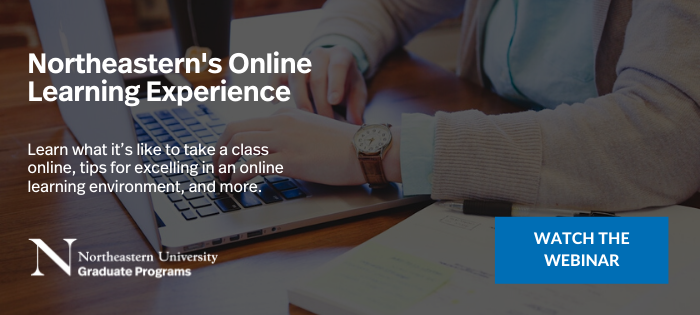
Schools at every level have relied on technology to educate students during the COVID-19 pandemic, developing customized solutions and embracing more widespread techniques for instruction. As they consider strategies for reopening, many schools, including Northeastern, are turning to blended learning models.
Through blended learning, which fully integrates in-person and online learning components, students and educators can get more out of the time they spend learning and teaching. Here’s what you need to know about this form of learning and how it can impact your education.
What is Blended Learning?
Blended learning refers to the integration of in-person classroom instruction with online components to provide more personalized learning experiences. This does not mean that students are simply using technology in the classroom or viewing information about the class and its content online later, however. Instead, the work they do in class is developed to reinforce their online learning and vice versa. For example, this may be achieved by asking students to engage with each other in an online discussion board, and then addressing themes of that discussion through small group analysis or projects in class.
While some instruction in a blended learning environment takes place according to a set schedule, students often have a level of control over the timing, pace, assignment or project type, and location of their learning. For instance, they may be able to choose whether they’d prefer to complete online tasks in the morning or at night, then continue additional assignments if they finish their work ahead of schedule.
Blended learning can be further personalized by offering different modalities students can choose from—such as the option to watch a video or read a short chapter to get the information they need—as well as through data collection and analysis. Systems that track a student’s progress, match them up with the best modality for their needs, and alert instructors to areas in which the student may require additional support, can all help to create a tailored learning environment that will best benefit a student’s unique needs.
Northeastern’s Online Learning Experience
Learn what it’s like to take a class online, tips for excelling in an online learning environment, and more.
Blended Learning Models
Educators have a great deal of flexibility when designing blended learning environments. They can choose which elements of a course are presented online or in the classroom, how they want to structure their materials, and more. The following are four basic blended learning models that instructors may choose as a foundation.
The Rotation Model
In the rotation model of blended learning, students in a single class—such as history or science—rotate between various learning modalities according to a predetermined schedule set by their instructor. Teachers can set up stations on a circuit, or simply offer several activity options and switch between online and face-to-face instruction.
The Flex Model
Flex learning involves switching between online and face-to-face methods of teaching on a customized, fluid schedule. Students can choose their own activities and the timing of each one within approved parameters, offering them unprecedented agency in their own education. Both online and in-person activities take place primarily at school.
The A La Carte Model
Students in an a la carte environment take some classes mostly online and some mostly at school, choosing their preferred methods of learning for each class. This gives students a great deal of flexibility and allows them to better match their learning to their schedules.
The Enriched Virtual Model
In the enriched virtual model, learning is divided into online and offline days, often resulting in less of a need for students to come to campus every day. The primary mode of learning in this model is instead online, and students attend an in-person class only once or twice per week to meet with their teacher.
4 Benefits of Blended Learning
Students and teachers alike can benefit from a blended learning environment. No matter which model is used, blended learning can offer high levels of satisfaction, information retention, and more. Here we offer four of the top benefits you can expect from implementing blended learning in the classroom.
1. Personalization
Blended learning offers each student the opportunity to choose the learning path that works best for them. They can often decide whether to learn at home or at school, select different ways of receiving information and demonstrating their knowledge of it, and set the pace at which they complete their work. Rather than begin learning new topics on a set schedule or in a specific way, students can move on when they’re fully ready, improving their mastery of the information.
2. Flexibility
Teachers and students both see improved flexibility with blended learning. Students receive more options regarding when, where, and how they learn, while teachers enjoy the ability to dedicate more personalized time to each student. As some students work independently in class, teachers can work one-on-one with others who might benefit from closer attention. Teachers can also use a wider variety of teaching and assessment tools, which can in turn allow them to pivot between different strategies when needed to save time or improve effectiveness.
3. Efficiency in Addressing Needs
With the integration of many online and digital tools, blended learning allows teachers to collect a wide array of information about their students’ needs. This information can then be used to help teachers formulate a plan on to address those needs. Instead of relying on tests and homework to assess progress, teachers can also use metrics like the speed at which students move on to new tasks, which types of assignments they typically select, how they prefer to communicate, and more to ensure each student has the necessary resources they need to succeed. For example, a student who rarely speaks in class but actively participates in online activities may need more written assignments or more support in the classroom to best retain and master information.
4. Better Soft Skills
Blended learning requires students and teachers to communicate through a wider variety of methods, including email, discussion boards, and video. This gives teachers the ability to connect with students in multiple ways while also helping students learn how to clearly communicate through various channels. Students can also learn how to make better connections with their peers and teachers, practice time management skills, and think critically. These soft skills can benefit students both personally and professionally.
Blended Learning in Action
Northeastern offers blended learning through hybrid courses, which combine online and in-person classes in a flexible format designed to meet the needs of working professionals. Hybrid courses are available at both the graduate- and undergraduate-levels across the university’s regional locations, and allow professors to customize their strategies based on the needs of their students. These courses are dynamic and interactive, creating an engaging learning environment for students while simultaneously providing professors with in-depth assessment and teaching tools.
In response to the need for innovative learning options amid the COVID-19 pandemic, Northeastern is also implementing the NUflex program, which leverages flexible schedules, classroom instruction, online learning, and extensive technology tools. Students can choose to take some or all of their classes online from anywhere in the world, and those living on campus can attend classes in person according to a personalized schedule. These schedules can be altered at any time to meet the changing needs of each student and give everyone the opportunity to learn in-person if they so choose. Students attending class online can view recorded lessons at a later time or participate live at the class’s scheduled time.
Learn more about NUflex and Northeastern’s hybrid learning models here. And to learn more about Northeastern’s online learning experience, watch the webinar below.






Related Articles
Why Earn a Professional Doctoral Degree?
5 Tips to Get the Most out of Grad School
Is Earning a Graduate Certificate Worth It?